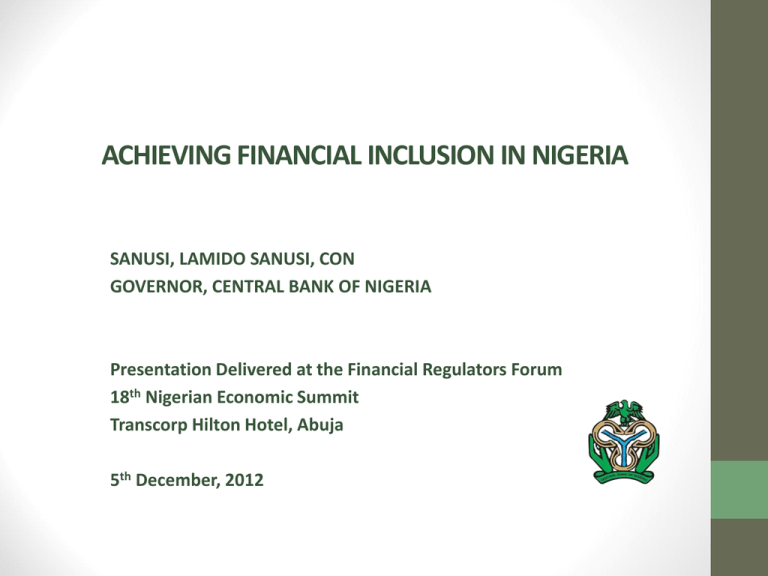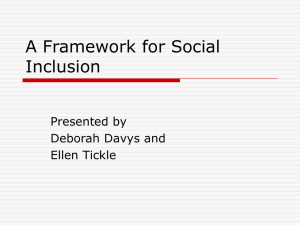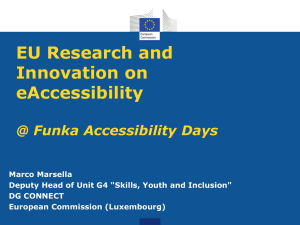achieving financial inclusion in nigeria
advertisement

ACHIEVING FINANCIAL INCLUSION IN NIGERIA SANUSI, LAMIDO SANUSI, CON GOVERNOR, CENTRAL BANK OF NIGERIA Presentation Delivered at the Financial Regulators Forum 18th Nigerian Economic Summit Transcorp Hilton Hotel, Abuja 5th December, 2012 OUTLINE Introduction State Of Financial Inclusion In Nigeria Nigeria’s Path To Financial Inclusion National Financial Inclusion Strategy (NFIS) Role Of The CBN in Financial Inclusion Role Of The Major Stakeholders In Financial Inclusion Progress Made Towards Financial Inclusion Conclusion 2 INTRODUCTION The Central Bank of Nigeria (CBN) launched the National Financial Inclusion Strategy (NFIS), in October 2012 The NFIS is a concerted attempt to increase access to a range of financial services such as payments, savings, remittances, pension, insurance and credit at an affordable cost to consumers Having a financial inclusion strategy can lead to improved income, poverty reduction and a stable financial system Global efforts toward financial inclusion date back to 2009, when a Financial Inclusion Summit was convened in Pittsburgh, U.S.A as part of the G20. So far, over 60 countries have initiated financial inclusion reforms in recent years 3 STATE OF FINANCIAL INCLUSION IN NIGERIA Nigeria’s rate of financial exclusion is currently at 39.7%, according to the 2012 survey conducted by Enhancing Financial Innovation and Access (EFInA) Formally banked Adults who has access to or use financial services supplied by ‘Deposit Money Banks’ Formal other Adults who has access to or use formal financial services and financial products not supplied by ‘Deposit Money Banks’ Informal only Adults who has access to or use any unregulated financial institution or informal service, such as cooperatives or moneylenders Completely Excluded Adults without formal or informal financial products Source: EFInA Access to Financial Services in Nigeria 2012 survey 4 NIGERIA’s PATH TO FINANCIAL INCLUSION Efforts at financial inclusion in Nigeria date back to 2005 with the launching of the Microfinance Policy, Regulatory and Supervisory Framework, subsequently revised in 2011 Key elements which the Policy sets out to achieve are: Assist Microfinance Banks to set up an Apex Regulatory Body Establish a Microfinance Certification Programme Set up credit bureau Promote the setting up of rating agencies for Microfinance Banks Establish Micro, Small and Medium Enterprises Development Fund (MSMEDF) The Central Bank of Nigeria has delivered on all of the above except the MSMEDF on which we are working to finalize modalities and guidelines for its implementation 5 NIGERIA’s PATH TO FINANCIAL INCLUSION In 2011, Financial Regulators from 20 developing countries including Nigeria made financial inclusion commitments referred to as the “MAYA DECLARATION”, in Rivera Maya, Mexico The pledge seeks to: Create an enabling environment that substantially lowers the cost of financial services through the deployment of innovative technology Implement a sound and appropriate regulatory framework that balances the goals of financial inclusion, integrity and stability Recognize consumer financial inclusion Make evidence-based financial inclusion policy a priority by collecting and analyzing comprehensive data protection and empowerment as key pillars of 6 NIGERIA’s FINANCIAL INCLUSION STRATEGY Nigeria, through its Maya Declaration is committed to reduce its rate of financial exclusion from 39.7 per cent in 2012 to 20.0 per cent of the population by 2020 through the implementation of seven key interventions: Simplified KYC Framework Agent Banking Regulatory Framework National Financial Literacy Framework Consumer Protection Framework Mobile-Payments and “Cash-less” Policy Initiative Establishing Linkages between government, DFIs, DMBs and MFBs / MFIs Introduction of Credit Enhancement Schemes and Programmes – MSMEDF, NIRSAL and EDCs 7 NIGERIA’s FINANCIAL INCLUSION STRATEGY Key interventions are expected through the following targets to directly reduce the rate of financial exclusion from 39.7 per cent in 2012 to 20.0 per cent of the population by 2020 8 Source: National Financial Inclusion Strategy (2012) ROLE OF THE CBN IN FINANCIAL INCLUSION CBN aims to reinforce its function in ensuring monetary stability and sound financial structure, so as to enhance economic development In addition to implementation of seven key interventions, the Bank will continue to adopt some specific models to help drive financial inclusion Transformation of the payment system Ensuring healthy financial evolution through the development of specialized banks and alternative sources of finance Financial Education and Consumer Protection Creating effective policy and regulatory environment that empower and protects the populace - Financial System Stability Framework 9 ROLE OF THE MAJOR STAKEHOLDERS IN FINANCIAL INCLUSION The Financial Inclusion Strategy clearly provides the road map for the activities of all stakeholders in the provision of financial services for growth and development of the economy. There are three major stakeholders in the National Financial Inclusion Strategy (NFIS) namely: The ‘Providers’ – financial institutions and partner infrastructure and technology providers – DMBs, DFIs, MFBs / MFIs, NIBSS, Telcos … The ‘Enablers’ - regulators and public institutions responsible for setting regulations and policies in respect of financial inclusion - FSRCC ‘Supporting Institutions.’ Partners and experts with the mission to support Nigeria in meeting its economic objectives and delivering on their technical assistance mandates – IFIs and NGOs 10 PROGRESS MADE TOWARDS FINANCIAL INCLUSION The Financial Inclusion Strategy has been validated and launched A Consumer Protection Department and a Financial Inclusion Secretariat within the CBN have been established Strategic alliances to develop agent banking initiated with the Nigerian Communications Commission (NCC) and the Nigerian Postal Service (NIPOST) The cashless policy implementation, which commenced in Lagos, has been reviewed and would be extended to other States of the Federation with refinements The Nigeria Incentive Based Risk Sharing System for Agricultural Lending (NIRSAL) has been given presidential approval and is being implemented A ‘Financial Literacy Framework’ and ‘Guidelines for Agent Banking’ are being finalized 11 CONCLUSION Financial sector operators are to implement the strategy, while the oversight function resides with the Financial Services Regulatory and Coordinating Committee (FSRCC) Optimistic that despite some of the challenges highlighted, with commitment and determination, we shall collectively reach our goal An affirmation that we are determined to drive this process and make the Nigerian financial inclusion model a trademark for other countries to replicate 12 I thank you all for your attention… 13






